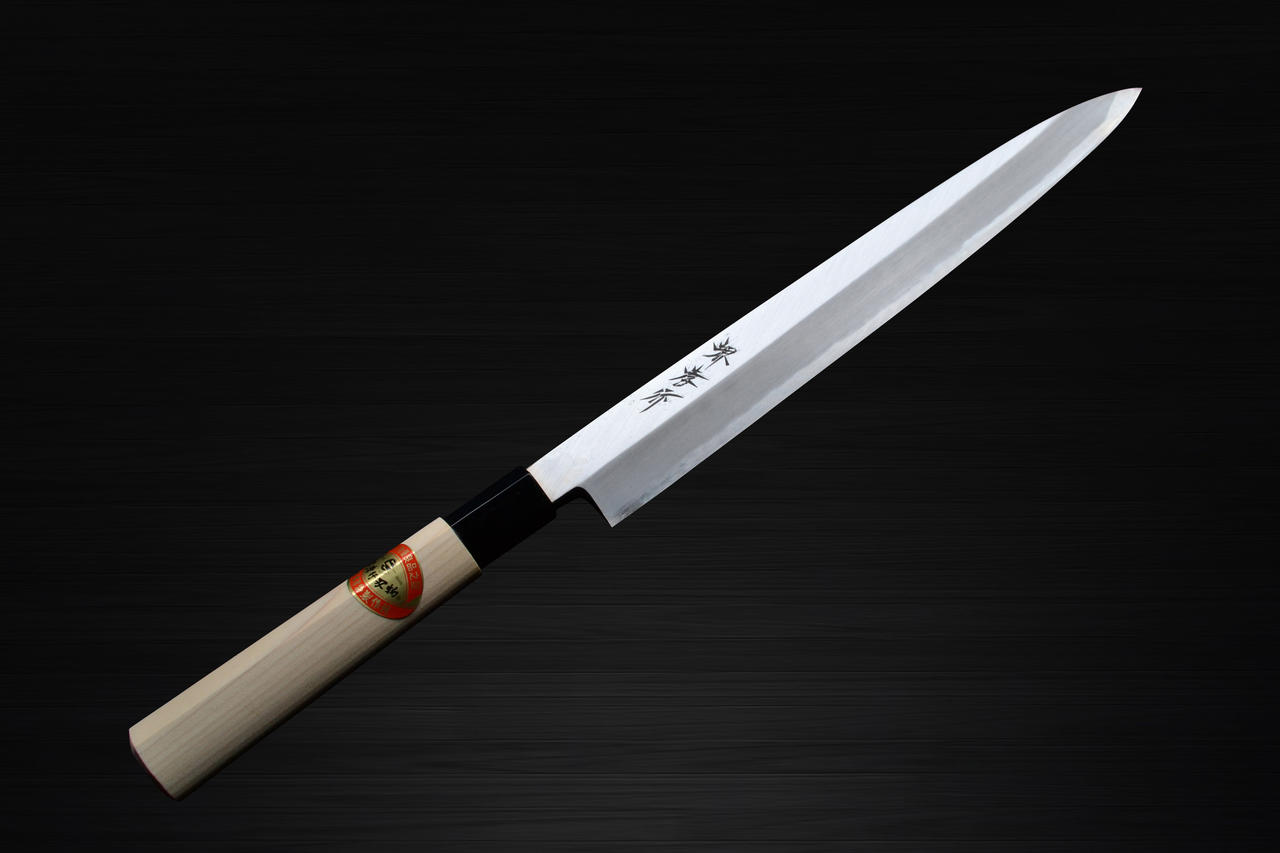Sakai Takayuki Shikisai Kasumitogi (White Steel) Japanese Chef’s Yanagiba (Sashimi) 240 mm Akebono with Saya Sheath

img by : https://www.hocho-knife.com/
Japanese chefs are always in the search for fine quality blades, the exquisite knives to perform what it needs to craft delicate, yet exotic culinary pieces. To make that happen, cutlery is highly essential – not just any ordinary one, but a specialty knife to do all the required tasks. Although knives might sound like just any other common tools used in a kitchen, for Japanese cuisine it is all that matters most. The skills of the blade determine the taste of each dish – it is what truly matters specifically when it comes to the crafting of ‘Sashimi’.
There are a plenty of Japanese knife types like those of Gyuto, Santoku, Bunka, Nakiri, Yanagiba, Usuba, Deba, and so on. Each knife has its own uses – for example, the Gyuto knife is also known as a chef’s knife, often used for multi purposes, while Nakiri knives are used especially to cut and chop vegetables. Japanese cuisine involves intricate processes which include: the selection of fine ingredients, the seasoning of various components, the mastery of the blades, and the delivery of passion through culinary aesthetics served on traditional, Japanese dishware. With this being important to Japanese chefs and professionals in the culinary world, Japanese knives play a significant role in the crafting of Japanese cuisine, specifically ‘Sushi’.
Sushi is the world’s most loved Japanese cuisine
Where its popularity can be witnessed by the continuous growth of sushi stalls and Japanese restaurants worldwide. Its fame arise from the words of mouth – the spread of rumors claiming it one of the most unique, yet alluring dish featuring raw ingredients some couldn’t even imagine edible. However, through the swift slices of the blade, the perfect strokes, and creative dabs of this and that, sushi became a world phenomenon in less than a decade.
Gourmets wouldn’t believe in the idea of consuming raw fish at first, but after the introduction of sushi, raw Salmon and Fatty Tuna became a divine, heavenly ingredient. Crafting delicate pieces of delicious, mouth-watering sushi requires professional knife skills to make perfect chops, clean-cut slices, and to provide just the right balance in the flavor of the dish itself. Having a good blade – one with a simple, comfortable grip to hold onto, one that is appropriate for a specific technique or skill, and one that is durable and sharp is important to Japanese chefs, which explains why Japanese knives are so much in high demand.
Sakai Takayuki Yanagiba Knife
Among Japan’s top-tier knife brand, Sakai Takayuki is most known for its wide variety of knife types forged out of high quality steel like White Paper Shiogami, Blue Paper Aogami, Kigami, and so on. Handle materials like those of gemstones and fine quality wood are also their major selection of materials used to ensure there is support and efficiency in grips. Among Sakai Takayuki knife models, the Sakai Takayuki Shikisai Kasumitogi (White Steel) Japanese Chef’s Yanagiba (Sashimi) 240 mm Akebono with Saya Sheath is a knife indeed worth the keep.
Sakai Takayuki Shikisai Kasumitogi (White Steel) Japanese Chef’s Yanagiba (Sashimi) 240 mm Akebono with Saya Sheath is among the most traditional Japanese knife models Sakai Takayuki has made. Made out of soft, kitchen knife iron on Yasugi’s traditional Nihonko or Hagane Shiroko White Paper no.3 steel, it is extremely sharp, durable, and has a good edge holding. Its unique d-shaped handle is delicately made out of Magnolia with a food-grade, hygienic Urethane coating. Sakai Takayuki Shikisai Kasumitogi (White Steel) Japanese Chef’s Yanagiba (Sashimi) 240 mm Akebono with Saya Sheath is also known for its extraordinary sheath design, also coated with hygienic Urethane for food. With a blade length of 240mm, this is indeed a great knife for the crafting of perfect Sashimi pieces.
